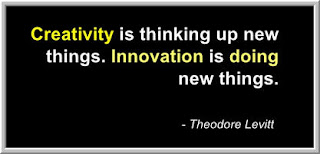I've spent a chunk of time this morning reading what's out there in social media regarding trading, trading psychology, and trading methods. A lot of sites, a lot of tweets. A lot of what I read boils down to, "Once you've found your edge, stay consistent in your mental/emotional state and in your trading practices."
Why is it that so many professional money managers (not to mention individual traders) fail to meet performance expectations?
I would argue that the reason is that they have followed their own advice. They found their edge, they stayed consistent with it, and they have been left behind as markets have changed. In other words, traders have failed because there is much, much more to trading psychology than maintaining emotional control and following routines.
Successful traders and trading firms create and innovate--just like any successful business. They operate in a dynamic environment and they find ways to adapt and exploit *new* sources of edge as the marketplace evolves. The Achilles heel of trading psychology is that it emphasizes the process of trading and not the process of generating fresh ideas worth trading.
Creativity and innovation begin by looking at new information, questioning old assumptions, and using the new information to explore alternate assumptions.
Here's an example from my recent trading: What if backtesting a historical set of data is *not* the best way of determining the odds of a market moving from point A to point B? What if a better predictor is the recent behavior of market participants at points A and B?
The new data consists of very short-term readings of the upticks and downticks occurring among all exchange-listed stocks throughout the day. (Available via e-Signal). Instead of arraying the uptick/downtick data by time, we array it by price level: we look at each price and how much net upticking/downticking has occurred at that price. (Note that this is similar to arraying volume by price in a Market Profile).
What we find is that there are certain price levels and ranges at which buying (upticking) and selling (downticking) has been dominant. Perhaps these price levels/ranges represent where the inventory lies in markets. Perhaps the odds of moving through a given price/range is a function of that inventory.
Maybe yes, maybe no; I have an open mind. What I do know is that this is a different way of looking at markets and modeling forward returns. I don't know if any given innovation will yield an edge, but I am convinced that the failure to innovate will allow any possible pre-existing edge to erode.
Looking at new information. Questioning old assumptions. Asking new questions. Viewing markets from different angles. These lie at the heart of what I call Trading Psychology 2.0. The challenge isn't simply to succeed, but to sustain success.
Further Reading: Creativity is the New Discipline
.
Why is it that so many professional money managers (not to mention individual traders) fail to meet performance expectations?
I would argue that the reason is that they have followed their own advice. They found their edge, they stayed consistent with it, and they have been left behind as markets have changed. In other words, traders have failed because there is much, much more to trading psychology than maintaining emotional control and following routines.
Successful traders and trading firms create and innovate--just like any successful business. They operate in a dynamic environment and they find ways to adapt and exploit *new* sources of edge as the marketplace evolves. The Achilles heel of trading psychology is that it emphasizes the process of trading and not the process of generating fresh ideas worth trading.
Creativity and innovation begin by looking at new information, questioning old assumptions, and using the new information to explore alternate assumptions.
Here's an example from my recent trading: What if backtesting a historical set of data is *not* the best way of determining the odds of a market moving from point A to point B? What if a better predictor is the recent behavior of market participants at points A and B?
The new data consists of very short-term readings of the upticks and downticks occurring among all exchange-listed stocks throughout the day. (Available via e-Signal). Instead of arraying the uptick/downtick data by time, we array it by price level: we look at each price and how much net upticking/downticking has occurred at that price. (Note that this is similar to arraying volume by price in a Market Profile).
What we find is that there are certain price levels and ranges at which buying (upticking) and selling (downticking) has been dominant. Perhaps these price levels/ranges represent where the inventory lies in markets. Perhaps the odds of moving through a given price/range is a function of that inventory.
Maybe yes, maybe no; I have an open mind. What I do know is that this is a different way of looking at markets and modeling forward returns. I don't know if any given innovation will yield an edge, but I am convinced that the failure to innovate will allow any possible pre-existing edge to erode.
Looking at new information. Questioning old assumptions. Asking new questions. Viewing markets from different angles. These lie at the heart of what I call Trading Psychology 2.0. The challenge isn't simply to succeed, but to sustain success.
Further Reading: Creativity is the New Discipline
.





